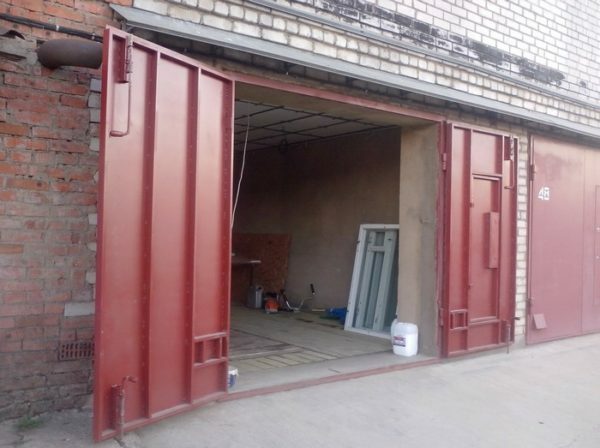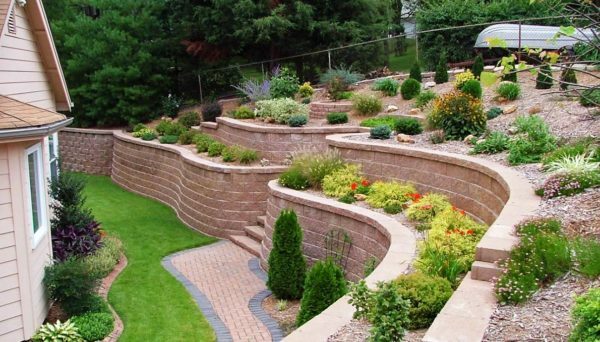Timber frame house: the pros, cons, and especially the construction of
Table of contents
- 1 What it is
-
2 evaluation
- 2.1 pros
- 2.2 Minuses
-
3 How to build
- 3.1 Foundation
- 3.2 Bottom rail, grillage
- 3.3 Racks cantrail
- 3.4 lags
- 3.5 truss system
- 3.6 Sheathing and insulation
- 3.7 trim
- 4 conclusion
Dreaming of your own home and as the primary option considering frame houses? Let's weigh the pros and cons of frame construction and look at its key features. Also, I will tell in detail all the stages of the construction of the structure.
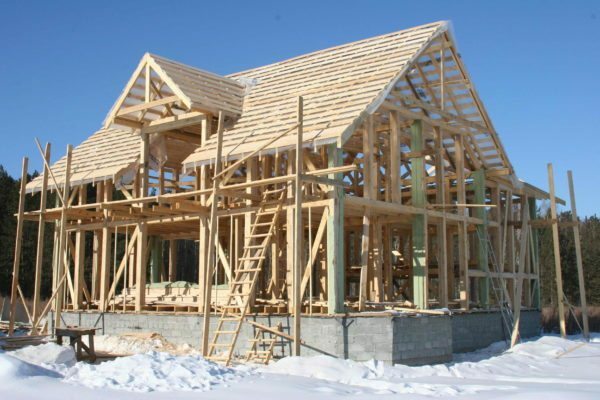
Wooden karkasnik under construction.
What it is
Strictly speaking, to frame include any structure based prefabricated wooden or metal frame. However, in a well-established construction practice so called very specific structure:
- The basis of a building - frame made of beams (usually from lung softwood - pine, spruce and fir);
- frame paneling with one or two sides is performed plywood, wood paneling, cement particle board or oriented strand board;
-
The space between the inner and outer skinsfilled insulation - mineral wool, polystyrene, ecowool (natural insulation based on cellulose), sawdust and other insulating materials.
If the DSP is resistant to prolonged contact with water, the water-resistant plywood or OSB can not boast. Therefore, the external facade finishing performed waterproof materials: steel sheets, siding (Metallic or vinyl) or façade plasters acrylic-based (pitted, and Kameshkovo etc.).
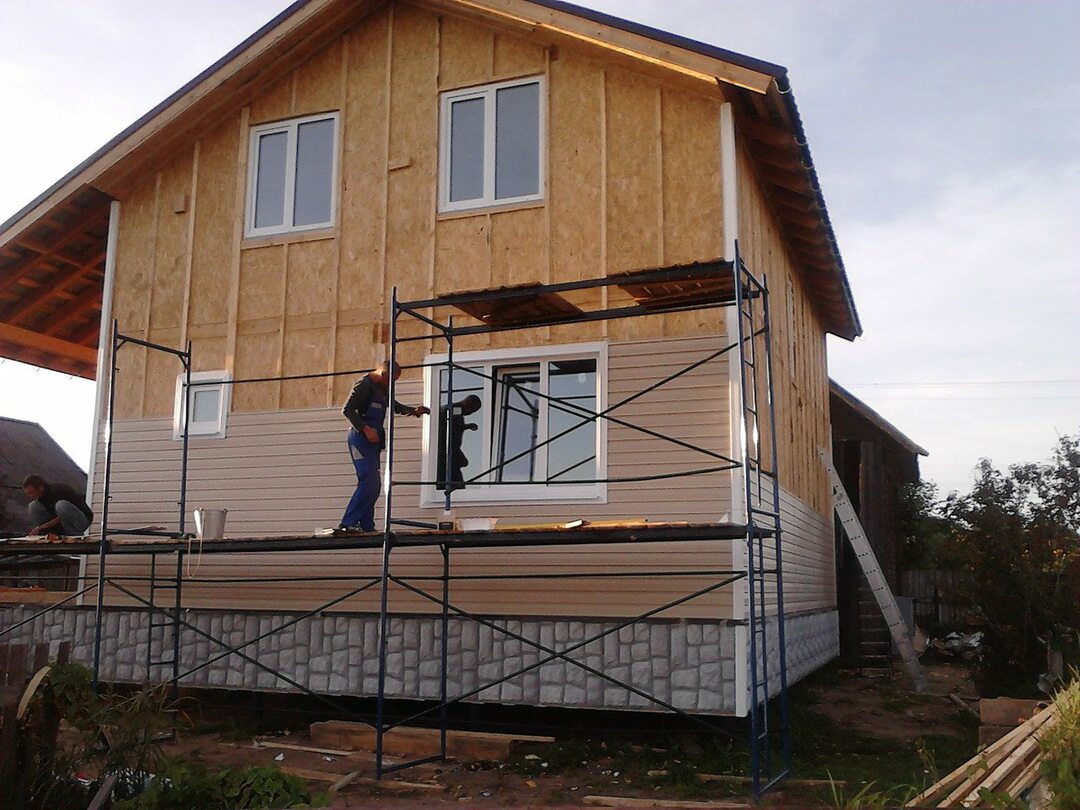
Siding will reliably protect the house from the damp walls.
evaluation
Let's try to frame technology assessment, weighing its benefits and imperfections.
pros
- The high speed of construction. The construction of the home area of 150 square meters occupies the builders brigade about 8 weeks;
- Relatively low price square meter. In Sevastopol, where I live, the construction of frame houses under the key costs about 15,000 rubles per square at the cost of the same square meter in a new building at the level of 40,000 and above (the prices are relevant for the spring 2017);

Frame houses in Sevastopol are offered at the rate of 10,000 rubles per square undecorated and 15000 rubles per 1 m2 in a completely finished state.
However: the construction of houses under the key of aerated concrete or limestone will cost slightly more expensive - 17 - 20 thousand rubles per square.
- Durability design of the house to the ground shifting of. If the soil prosyadet under the weight of the house, a stone wall will crack, the wood in the worst case, get off with little deformation;
- The minimum weight of the building. This means savings in both the foundation and the minimum probability notorious subsidence and deformation under the effect of frost heaving soil;
Not only that: the foundation under the house retains maintainability. The stiffness of the wall in conjunction with the low weight of the house (usually no more than 10-20 tons) allows jacks to lift it to replace a screw pile or pile cap area.
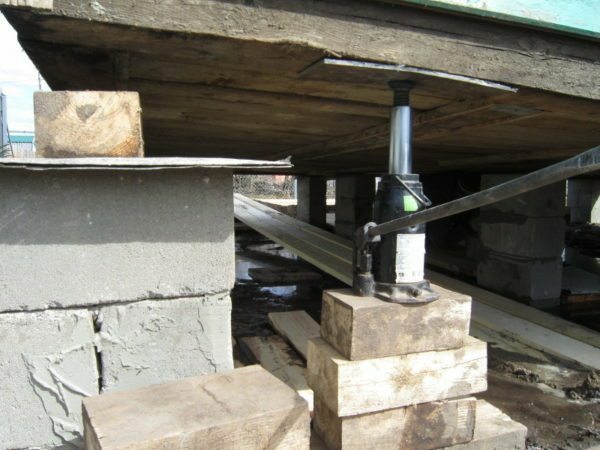
Low weight allows the house to pick it up if necessary jacks.
- Construction can be carried out at any time of the yearBecause the technology does not involve the erection of the box "wet work" that can not be carried out at low outdoor temperatures;
- A box of the house can expel their own handsWithout involving loading technology: the most difficult elements of its construction (joists and studs) weigh no more than 60-80 kg;
- In winter the house very quickly warms to a comfortable temperature. This is due to the low thermal conductivity and heat capacity of the wall filled with insulating material;
For the same reason your heating costs will be minimal. Usually designs of frame houses laid specific power boiler at 40-50 watts per square meter against 70-120 W / m 2 for the stone houses.
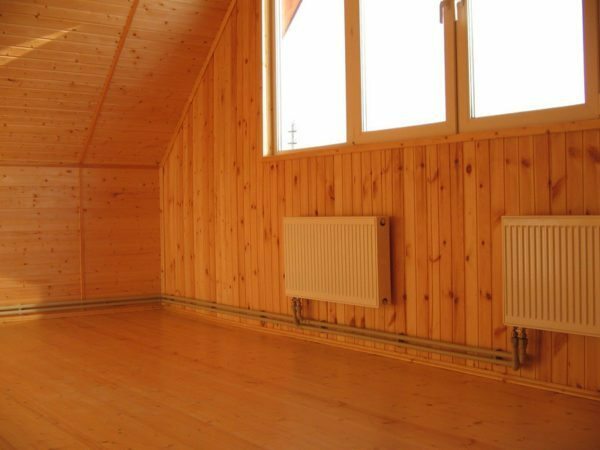
Thanks to the excellent thermal insulation of heating of the house will not break the bank.
- The walls and the roof can be given arbitrarily complex shape, Without compromising the strength of load transfer to the foundation (light weight, remember?);
- The water vapor permeability of the walls when using wood-based materials is high enough to allow excess moisture to freely leave the premises even without ventilation (and concomitant heat loss);
- Seismic resistance - another plus. Light weight and strength of the walls and the roof will save your family from serious trouble in a seismic zone.
Minuses
Comrades, you are full of admiration and adoration? And probably already making plans for the purchase of materials for their frame house? Do not hurry, let me desecrate your dream muddy boots cynical practice.
- Vandal-proof quality of the walls do not stand up to scrutiny. To crack house attacker enough to have in your arsenal ax or a chainsaw;
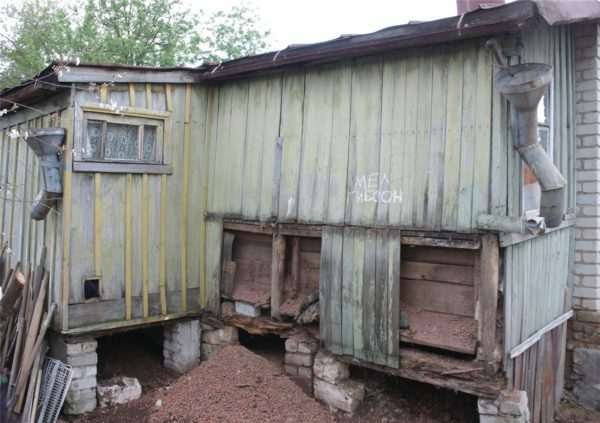
My home is my castle? Yes, you're kidding!
- Wooden structure - combustible construction. Overheating of the wiring or careless handling of fire (from the coal-fired boiler to lighters) can cause fire. Insurers are aware of this particular frame structures and equate them to the wood;
This disadvantage is offset by using carcass fireproof laminated or impregnated timber, and for its plating - DSP LSU (glass-sheet) and flame-resistant drywall. However, if the water vapor permeability of the walls will fall, depriving karkasnik one of its advantages.
- When using inexpensive materials of dubious origin suffer ecological construction. In particular, cheap OSB (primarily - Chinese) is often used as a binder with the class of phenolic resins phenol formaldehyde emission E2 and higher (normal value E1 or E0) and mineral wool can be a source of cancerogenic dust;
- Approximate lifetime frame house from a bar and the SIR is estimated at 40-50 years. Stone houses are not less than a century.
How to build
Foundation
In Crimea, light karkasniki built on the foundations of three types:
| Picture | Description |
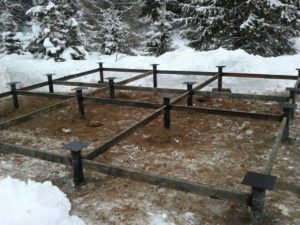 |
Screw: Screwed into the ground the pile of steel tubes with blades. They carry the burden on the lower, denser layers of the soil. Piles are interconnected grillage of timber end walls with steel or welded thereto steel channel. |
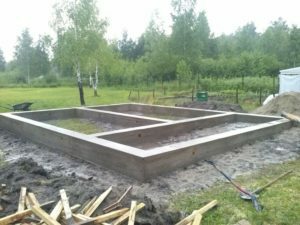 |
Melkozaglublenny belt: The trench depth to half with raised sides is lowered formwork reinforcement of corrugated rod with a diameter of 12-14 mm, and then the trench is filled with concrete and formwork mark M 250 M 300. Bottom rail anchors in the foundation walls on top of the waterproofing. |
 |
Columnar: on sandy cushions constructed low (less than 30-40 cm from ground level) of the pillars or blocks PBS red solid bricks. Grillage beams and laid on the waterproofing poles (its role is usually performed by two layers of roofing material). |
Bottom rail, grillage
For manufacturing sill walls commonly used timber-section of 100x100 mm of wood which is resistant to rot - larch or pine. The cross section of the grillage more - 150x150 - 200x200 mm.
Methods for mounting the beam to the base determined by its type:
- To a well head screw piles grillage bolted or hairpins with wide washers;
- Tying tape base and on grillage on pillars columnar foundations put on pre-drilled holes in the Anchors - incorporated by pouring or laying foundation studs (to the tape base) or armature segments (for columnar). Sill need to pull the tape base nuts with large washers.
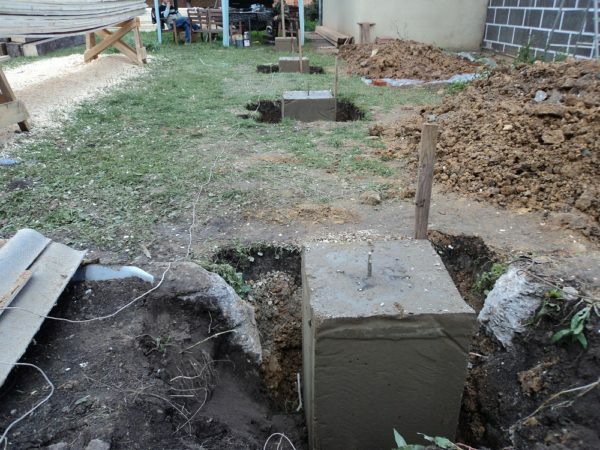
Pier foundation with a stuffy when casting anchor for fixing the grillage.
Racks cantrail
As racks and cantrail common to use beam size 100x50 mm from inexpensive softwood - spruce, pine and fir. Compounds struts with lower and upper strapping usually performed on galvanized parts and linings, fixed with screws 45-51 mm. For rigid fixation racks using jib from a bar of the same size.
If the construction budget is limited, on galvanized parts can save and secure the rack to trim nails hammered obliquely. When the carcass trim its elements bind attracted to him sheets of plywood or OSB.
Step between the uprights must be equal to exactly 60 cm on their axes. This is to ensure that the edges of adjacent sheets SIR with the standard 120 cm accurately accounted for the middle of each strut.
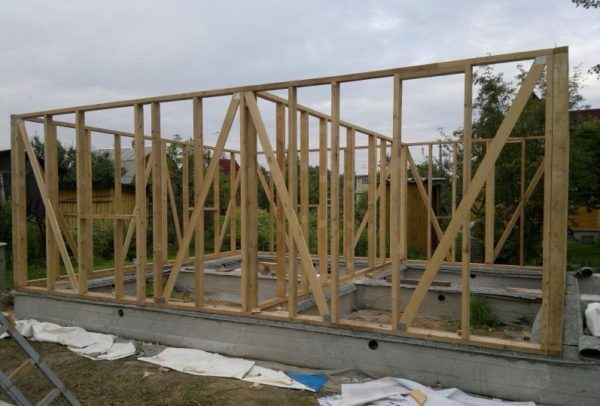
The assembled skeleton of the walls of the first floor. Jib mounted galvanized plates, racks - nails.
lags
Typical floor and lag the first section (if available) of the second / attic floors - 150h50 mm. Timber attached to the posts hammered obliquely nails or screws.
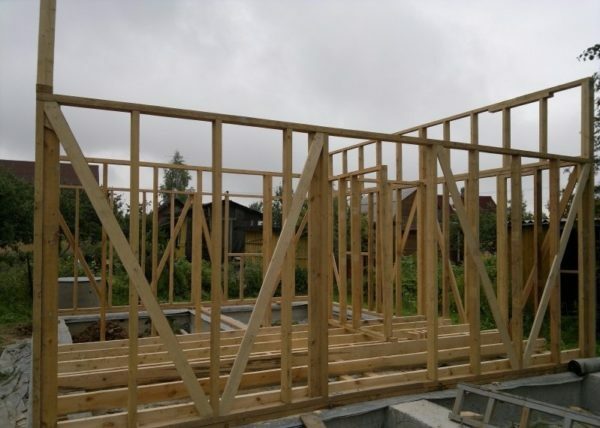
Future floor joists are fixed to the wall studs.
truss system
Several subtleties assembly truss system:
- horizontal tightening between rafter (beams) increase the rigidity of the roof and its ability to withstand snow loads;
Beams at the same time can become the basis for a horizontal ceiling in the attic. To do this, they must be at a height of not less than 2.4 meters above the finished floor.
- Crossbars are connected to rafters no screws, and missing timber through both bolts or pins with wide washers;

Truss system with horizontal puffs. Pay attention to the mounting crossbars to the rafters.
- Attach truss legs to the horizontal run and run to the posts We need metal plates: general skin, capable of providing resistance to wind load, they will not.
Sheathing and insulation
Skeleton is sheathed by sheet material (plywood, OSB, DSPs, and so on) from the outside, and then inserted into the insulation plate (e.g., mineral wool sized 600h1000 mm in size) between the uprights vrasporku. Vapor barrier is not necessary: a high water vapor permeability of the walls helpful. After warming the walls are sewn inside.
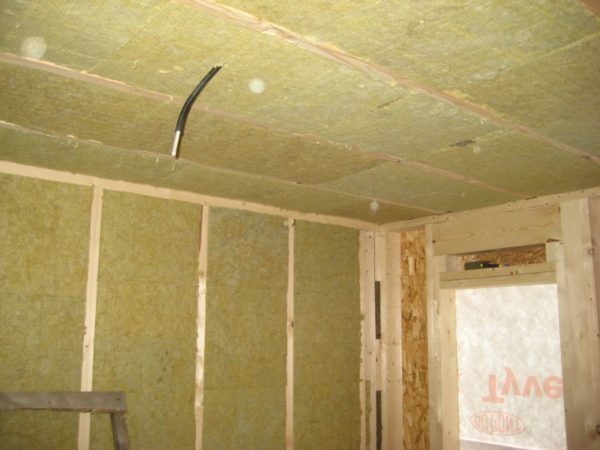
Wall insulation karkasnika.
trim
Construction of houses completed interior. How to get beautiful interior karkasnika with minimal effort?
I allow myself to share their own experiences framing attic decoration in your home.
Ceiling: The suspension of the FCL on galvanized profiles on straight hangers. Suspensions were fastened with screws directly to the rafters and beams.
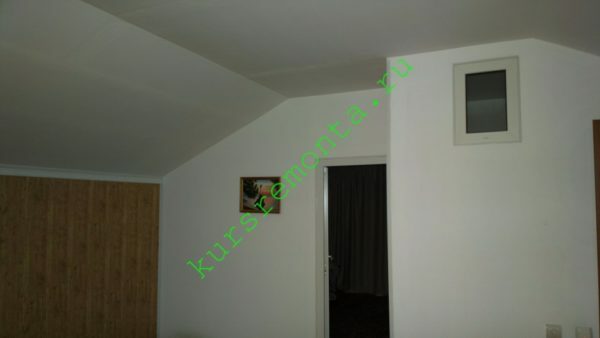
The photo - a plasterboard ceiling and walls separating room, bedroom and bathroom.
side walls12-mm plywood screwed to the posts under the mansard roof fracture. Floor Finish - wall panels made of MDF with vinyl lining film.
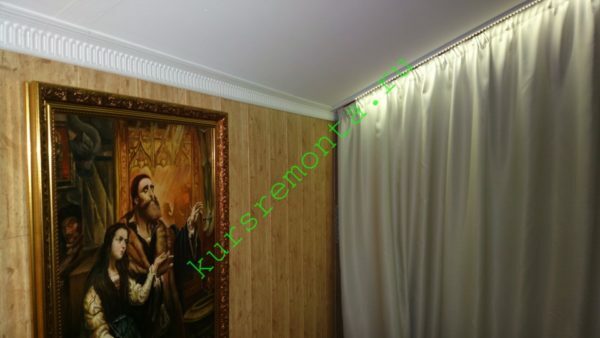
Plywood side walls are decorated with paneling made of MDF.
septaColored GCR on the frame of the rack profile.
Floor: Plank, 15 mm OSB on logs in increments of 30 cm. Floor Finish - 32 class laminate on a substrate of polyethylene foam.
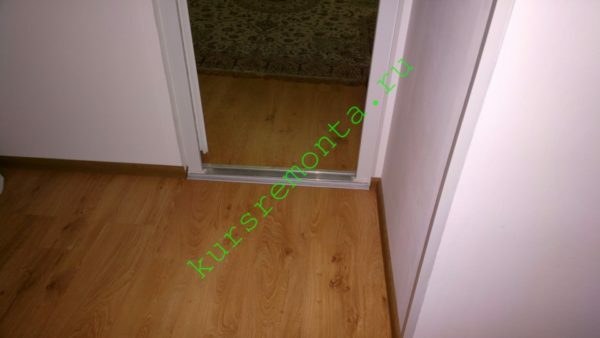
Since the attic - a dry room, the budget was laid laminate on the floor.
The total cost of finishing the attic were about 80 thousand rubles in 2013 prices. During 4 years of service, she has demonstrated its practicality and fully retain the original appearance.
conclusion
I hope this material will help dear reader to determine the ownership of the project construction. Learn more about how to build frame houses, you will help the video in this article. I am waiting for your questions. Good luck, comrades!
